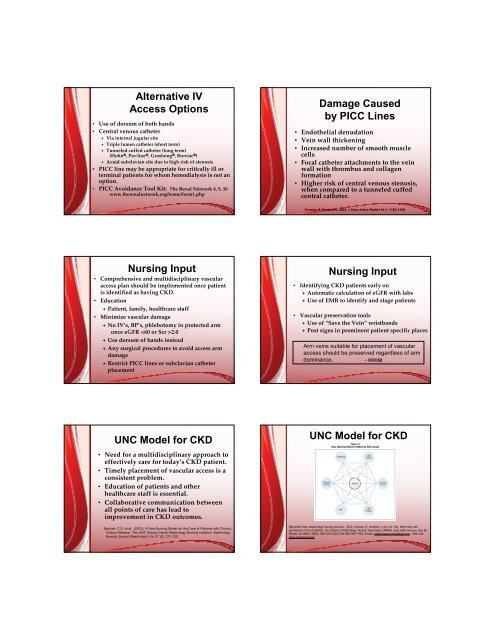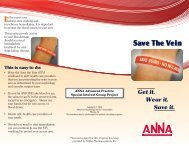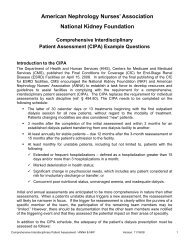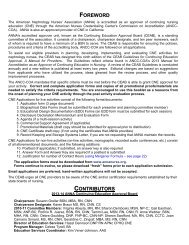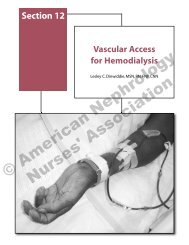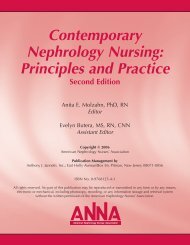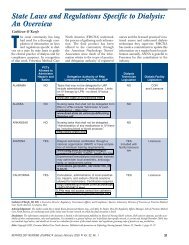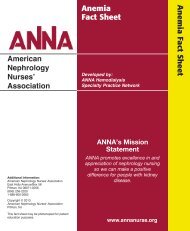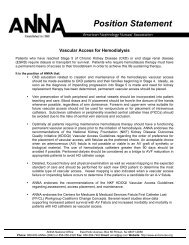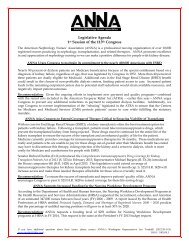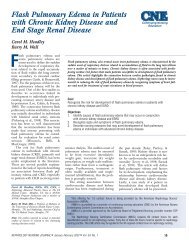ANNA Advanced Practice Special Interest Group Project - American ...
ANNA Advanced Practice Special Interest Group Project - American ...
ANNA Advanced Practice Special Interest Group Project - American ...
Create successful ePaper yourself
Turn your PDF publications into a flip-book with our unique Google optimized e-Paper software.
Alternative IV<br />
Access Options<br />
• Use of dorsum of both hands<br />
• Central venous catheter<br />
Via internal jugular site<br />
Triple lumen catheter (short term)<br />
Tunneled cuffed catheter (long term)<br />
(Hohn © , Pro-line © , Groshong © , Broviac © )<br />
Avoid subclavian site due to high risk of stenosis<br />
• PICC line may be appropriate for critically ill or<br />
terminal patients for whom hemodialysis is not an<br />
option.<br />
• PICC Avoidance Tool Kit: The Renal Network 4, 9, 10<br />
www.therenalnetwork.org/home/form1.php<br />
Damage Caused<br />
by PICC Lines<br />
• Endothelial denudation<br />
• Vein wall thickening<br />
• Increased number of smooth muscle<br />
cells<br />
• Focal catheter attachments to the vein<br />
wall with thrombus and collagen<br />
formation<br />
• Higher risk of central venous stenosis,<br />
when compared to a tunneled cuffed<br />
central catheter.<br />
Forauer & Theoharis, 2003. J Vasc Interv Radiol 14:1: 1163-1168.<br />
Nursing Input<br />
• Comprehensive and multidisciplinary vascular<br />
access plan should be implemented once patient<br />
is identified as having CKD.<br />
• Education<br />
Patient, family, healthcare staff<br />
• Minimize vascular damage<br />
No IV’s, BP’s, phlebotomy in protected arm<br />
once eGFR 2.0<br />
Use dorsum of hands instead<br />
Any surgical procedures to avoid access arm<br />
damage<br />
Restrict PICC lines or subclavian catheter<br />
placement<br />
Nursing Input<br />
• Identifying CKD patients early on<br />
Automatic calculation of eGFR with labs<br />
Use of EMR to identify and stage patients<br />
• Vascular preservation tools<br />
Use of “Save the Vein” wristbands<br />
Post signs in prominent patient specific places<br />
Arm veins suitable for placement of vascular<br />
access should be preserved regardless of arm<br />
dominance.<br />
- KDOQI<br />
UNC Model for CKD<br />
• Need for a multidisciplinary approach to<br />
effectively care for today’s CKD patient.<br />
• Timely placement of vascular access is a<br />
consistent problem.<br />
• Education of patients and other<br />
healthcare staff is essential.<br />
• Collaborative communication between<br />
all points of care has lead to<br />
improvement in CKD outcomes.<br />
Neyhart, C.D. et al. (2010). A New Nursing Model for the Care of Patients with Chronic<br />
Kidney Disease: The UNC Kidney Center Nephrology Nursing Initiative. Nephrology<br />
Nursing Journal; March-April; Vol 37 (2), 121-130.<br />
UNC Model for CKD<br />
Reprinted from Nephrology Nursing Journal , 2010, Volume 37, Number 2, pp 121-130. Reprinted with<br />
permission of the publisher, the <strong>American</strong> Nephrology Nurses' Association (<strong>ANNA</strong>), East Holly Avenue, Box 56,<br />
Pitman, NJ 08071-0056; 856-256-2320; FAX 856-589-7463; E-mail: nephrologynursing@ajj.com ; Web site:<br />
www.annanurse.org


